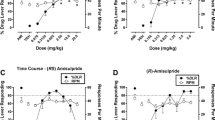Abstract
Rationale. The drug discrimination procedure has proven to be a valuable tool for studying the mechanism of action of psychoactive drugs. Recently, mice with targeted gene mutations have been developed that may also prove useful in evaluating the role of specific receptors in mediating the actions of drugs. We were interested in studying the effects of hallucinogens in genetically modified mice using the drug discrimination procedure.
Objective. To establish the training procedures and characterize the stimulus properties of 1-(2,5-dimethoxy-4-iodophenyl)-2-aminopropane [(±)DOI] versus saline in wild-type mice.
Methods. Using a two-lever drug discrimination procedure, C57BL/6J mice were trained to discriminate (±)DOI (2.5 mg/kg) from saline on a VI 30-s schedule of reinforcement.
Results. The acquisition function was orderly and similar to that found previously with rats, although the training dose required for the mice was four times higher (2.5 versus 0.75 mg/kg). The dose-response relationship indicated that percent drug lever responding was dose-dependent. Two other hallucinogens, LSD and (–)DOB, substituted fully for (±)DOI. Mice were tested for their ability to discriminate (±)DOI following pretreatment with the 5-HT2A receptor antagonist MDL 100,907, or with 5-HT2C selective antagonists, SB 206,553 or SB 242,084. A dose of 0.25 mg/kg MDL 100,907 essentially completely blocked the discriminative stimulus effects of 2.5 mg/kg (±)DOI. Surprisingly, both SB 206,553 and SB 242,084 also attenuated the effect of 2.5 mg/kg (±)DOI. The effect of SB 206,553 was surmountable at 5.0 mg/kg (±)DOI.
Conclusions. These data agree with the results from studies with rats indicating a prominent role for the 5-HT2A receptors in mediating the discriminative stimulus effects of (±)DOI but in addition, suggest a small but significant role for the 5-HT2C receptor in mice.
Similar content being viewed by others
Author information
Authors and Affiliations
Additional information
Electronic Publication
Rights and permissions
About this article
Cite this article
Smith, R.L., Barrett, R.J. & Sanders-Bush, E. Discriminative stimulus properties of 1-(2,5-dimethoxy-4-iodophenyl)-2-aminopropane [(±)DOI] in C57BL/6J mice. Psychopharmacology 166, 61–68 (2003). https://doi.org/10.1007/s00213-002-1252-6
Received:
Accepted:
Issue Date:
DOI: https://doi.org/10.1007/s00213-002-1252-6




